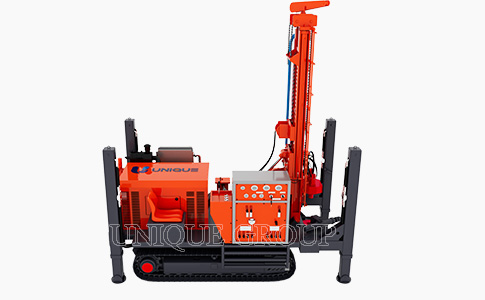As a professional manufacturer of blasting drilling rigs, we know that customers need to have a clear understanding of the characteristics of the product when choosing the equipment. In this article, we will analyse the difference between integrated and split DTH drilling rigs to help customers make a reasonable choice according to the actual needs.
I.Differences structure of the drillings
1.All in one DTH drilling rig: integrated design, compact and efficient
One-piece blasting rig is the core feature of the structure and function of a high degree of integration. The drilling rig host and the power system (such as air compressor) are integrated in the same chassis or frame through the integrated design, and the components are connected through the built-in pipelines and circuits to form a complete operating unit. This design significantly reduces the exposed components of the equipment, and the overall structure is more compact and relatively small, making it suitable for space-sensitive operating scenarios.
2.Separated DTH Drilling rig: Modular Separation, Flexible Adaptation
Split blasting drills are designed with a separate drill and air compressor. The drilling rig is responsible for drilling the holes, and the air compressor as a separate module provides the power source, and the two are connected through an external high-pressure pipeline. This split structure gives the machine greater flexibility:
Expandability: the air compressor can be used separately for other pneumatic equipment, realising multi-purpose use of the machine.
Convenient maintenance: If the compressor breaks down, it can be dismantled for repair or replaced by a spare unit without interrupting the operation of the rig.
Adaptability of transport: the split design makes the equipment easier to split and transport, especially suitable for complex terrain (such as mountains, jungles) handling needs.
II.Usage operate of comparison
1.All-in-one DTH Drilling rig: ready to use, operation is simplified
All-in-one drilling rig integrated structure determines the high degree of convenience of its operation process. Users only need to complete the basic commissioning (such as oil filling, circuit check), you can start the equipment and directly into the drilling operation. As the power system is designed in conjunction with the drilling rig, the air pressure and power output parameters have been optimised and matched in advance, eliminating the need for the operator to frequently adjust the pressure or speed, making it particularly suitable for scenarios that require high efficiency and fast-paced operations. For example, in urban building demolition projects, the construction team can quickly deploy the equipment and reduce preparation time.
Maintenance points: the sealing of internal pipelines should be checked regularly to avoid local faults caused by the integrated design affecting the overall operation.
2.Separated DTH drilling rig: flexible configuration, adapting to complex requirements
Separated drilling rigs need to complete the connection and debugging of the drilling rig and the air compressor before use, including pipeline docking, air pressure calibration and other steps. Although the preparation time is longer, the split structure has significant advantages in actual use:
Adjustability: Users can flexibly adjust the output pressure of the air compressor according to the hardness of the rock formation, drilling depth and other working conditions.
Fault tolerance: If any part of the drilling rig or air compressor fails, it can be shut down separately for maintenance, and the other part can still be called up temporarily.
Multi-tasking: In large-scale construction sites, one high-power air compressor can supply air to multiple drilling rigs at the same time, improving resource utilisation.
Typical application scenarios: In open pit mining, split drilling rigs can be connected by long-distance pipelines to achieve efficient coverage of multiple drilling sites.
III. Application scenarios Comparison
1.Integrated DTH drilling rig: accurate matching of small and medium-sized projects
Space-constrained scenarios: such as tunnel boring, basement piling works, the advantages of small equipment size and flexibility of movement are highlighted.
Short-cycle projects: municipal projects, small stone factories and other scenarios that require rapid completion, which can reduce the equipment assembly time.
Standardised operation: suitable for working conditions with relatively uniform rock conditions, relying on preset parameters to achieve stable output.
2.Separated DTH drilling rig: specially designed for large and complex projects
High-intensity continuous operation: such as deep hole blasting in large open pit mines, split air compressors can provide a continuous high-pressure air source to meet the demand for long-time operation.
Complex geological conditions: in multi-layer rock formations or areas with large differences in hardness, the drilling efficiency can be optimised by adjusting the parameters of the air compressor.
Multi-Equipment Collaboration Scenario: In mega projects such as water conservancy hubs and railway tunnels, the split design supports multiple drilling rigs to share the power source and reduce the comprehensive cost.
Preferred scenarios for the integrated type: small and medium-sized projects with limited operating space, tight schedule, and frequent equipment transfers.
Preferred cases: large-scale projects with high power requirements, complex and changing working conditions, and long-term high-intensity operation.



